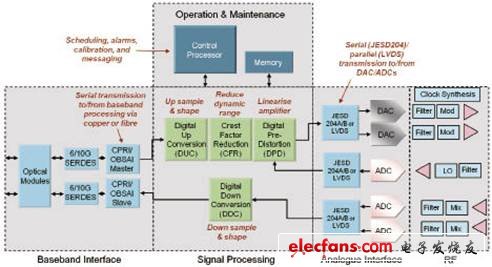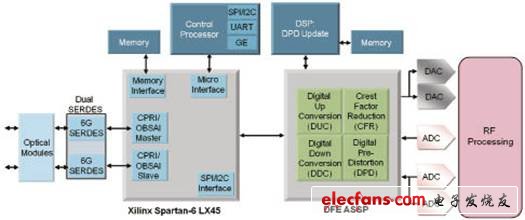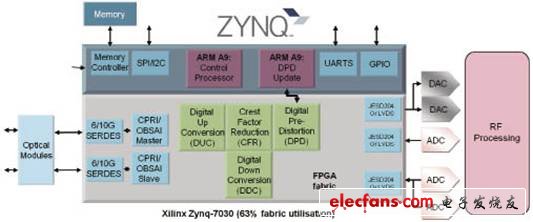While network operators strive to expand network capacity through the use of new air interfaces, higher bandwidth, and more cellular base stations, they require significant reductions in equipment costs. To provide equipment that meets all these needs, manufacturers of wireless infrastructure equipment are looking for solutions with higher integration, lower power consumption and cost, but greater flexibility. This article will analyze how the new device Zynq â„¢ Extensible Processing Platform (EPP) provided by Xilinx will help equipment manufacturers solve these problems.
The popularity of smartphones, tablets, and data hubs is driving explosive growth in the demand for ubiquitous high-speed data. To provide this data to meet their needs, network operators have to use the latest air interface standards such as LTE or LTE-A to build more cellular base stations and increase the number of antennas per base station. In addition, the continuous decline in average revenue per user (APRU) has caused operators to require equipment manufacturers to significantly reduce costs every year. To make matters worse, these new cellular base station networks may require the expansion of existing voice and data networks. The existing networks use GSM or UMTS standards and are deployed on different frequency bands.

Figure 1 High-level block diagram of a typical radio device
Whether it is to increase the number of antennas to support multiple frequency bands or to adopt multiple input multiple output (MIMO) technology to increase the data rate, although the cost is high, it is necessary for operators. In order to reduce the impact on the operating costs related to the antenna mast, equipment manufacturers are trying to reduce the package size of the equipment (ie, the volume and weight of the equipment), while also reducing costs and power consumption. They continue to innovate in the field of radio transmission, from the antenna to the duplexer / triplexer and even the radio equipment itself, and strive to reduce the package size of the antenna rod.
Operators can adopt a variety of solutions to meet their needs. One of them is the use of multi-band antennas, thereby reducing the number of antennas required to support multiple networks based on GSM, UMTS or LTE. To further improve these multi-band antennas, operators can install remote radios on the mast to provide support for the required frequency bands. Remote radios must also continue to evolve to support multiple air interfaces and higher bandwidths, while reducing weight and shrinking the chassis to meet the future needs of operators.
The rise of antenna-integrated radios provides operators with yet another option. This method installs the radio electronic device in the antenna case to realize a fully integrated radio and antenna, so there is no need to use a separate remote radio device, thereby minimizing the size of the antenna mast. The further development of radio electronics and antenna cases is the recently launched Active Antenna System (AAS). This complex antenna requires more powerful radio signal processing capabilities, which can increase the network capacity while reducing the antenna rod package size.
The key to reducing the size and weight of remote radios or antennas is to further improve the integration of radio electronics. In addition, in order to support multiple air interfaces such as GSM, LTE, UMTS, radio equipment must have a high degree of flexibility and programmable functions.
Let's take a look at how these radio devices can have better programmability, and at the same time can provide a higher degree of integration.

Figure 2 Typical 2x2 radio design based on ASSP

Figure 3 The new Zynq EPP series provided by Xilinx

Figure 4 2x2 LTE radio using Zynq
The function of the baseband interface is to connect the system to the copper fiber through the baseband processing card. The location of the baseband processing card can be on the base of the antenna mast or in the air. These interfaces generally require high-speed serial / deserializer (serdes) components running at speeds up to 9.8Gbps to be used as a common public radio interface (CPRI).
Before the signal received on the baseband unit or the signal sent to the baseband unit is sent to the analog domain or received from the analog domain, a large amount of signal processing is required. Signal processing includes digital up / down conversion (DUC / DDC), crest factor suppression (CRF), and digital predistortion (DPD). DUC and DDC are responsible for processing upsampling and shaping, while CRF and DPD are mainly used to improve the transmission efficiency of radio units by using digital signal processing to linearize power amplifiers.
Using high-speed parallel LVDS signal transmission or the emerging protocol JESD204 [A / B] can realize the interface to the data converter (DAC and ADC).
The radio frequency (RF) field includes all modulators, clock synthesis devices, filters, and amplifier circuits for sending and receiving digital signals from antennas via power amplifiers.
The entire radio is controlled by a microprocessor. The microcontroller generally runs on real-time operating systems such as Linux or VxWorks. The operation and maintenance function is responsible for the alarm, calibration, message transmission and overall control of the radio unit. This is a complicated task, and generally requires the connection of many other components such as SPI / I²C, Ethernet, UART (of course including memory).
In the past, suppliers used ASIC, ASSP, and FPGA devices to implement digital radio signal processing functions. ASIC devices have the weakest flexibility, and generally result in a lack of functionality due to locked-in specifications at the beginning of the design. Although the device has the lowest cost, development and NRE costs are high, and the time to market is slow. ASSP devices have limited flexibility because they are often designed for a range of use cases and are not suitable for other applications. FPGAs are not, because of their inherent high flexibility, the application in the field of digital radio is constantly growing. FPGA can support various equipment needs, and at the same time can continuously deliver new functions according to the development of customer needs. In many cases in this type of application, FPGAs are placed next to ASIC and ASSP devices to compensate for the lack of functionality of other devices.
China Glass Diffuser ,Glass Essential Oil Diffuser,Aromatherapy Essential Oil Diffuser Manufacturer
- Special Glass Cover Design: This glass diffuser is use Glass cover and PP water tank. It gives us a lovely aromatherapy, make us relax and enjoy our whole day.
- Super Quiet Operation: Using ultrasonic technology, this Aromatherapy Oil Diffuser produce smooth and continuous mist to humidify the air and fragrance home. Whisper-quiet operation won't affect quality of sleep.
- Waterless Shut-off: The Aromatherapy Essential Oil Diffuser with high capacity, gives a smooth mist and nice fragrance to bedroom, and will shut-off auto when the water runs out.
- Gorgeous 7 Colors Light: This Aromatherapy Essential Oil Diffuser has 7 changing color lights, each colors can be changed or fixed, creating a calm and soft atmosphere when you are working, reading, studying or sleeping.
Glass Diffuser
Glass Diffuser,Glass Essential Oil Diffuser,Aromatherapy Essential Oil Diffuser,Aromatherapy Oil Diffuser
Shenzhen Dituo Electronic Co.,Ltd. , https://www.sz-dituo.com